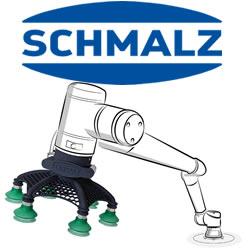RE2 Robotics Selected by the U.S. Department of Energy to Develop a Robotic Manipulation Solution for Solar Field Construction
The O-AMPP program will enable RE2 to apply its outdoor, autonomous robotic technology, which uses state-of-the-art computer vision and machine-learning techniques, to the solar construction industry. RE2’s mobile robotic arm capability will be optimized to support the transfer, manipulation, and placement of photovoltaic (PV) modules to enhance the process for solar field assembly.
PITTSBURGH, PA - March 2, 2021 - RE2 Robotics, a leading developer of intelligent mobile robotic manipulation systems, announced that is has been selected for award of $1.9 million in funding from the U.S. Department of Energy Solar Energy Technologies Office (SETO) to develop a robotic system for the Outdoor Autonomous Manipulation of Photovoltaic Panels (O-AMPP).
The O-AMPP program will enable RE2 to apply its outdoor, autonomous robotic technology, which uses state-of-the-art computer vision and machine-learning techniques, to the solar construction industry. RE2's mobile robotic arm capability will be optimized to support the transfer, manipulation, and placement of photovoltaic (PV) modules to enhance the process for solar field assembly.
"RE2 will utilize its extensive experience and technological foundation in autonomous manipulation to customize and integrate a robotic arm for this program," said Dr. Amanda Sgroi, principal research scientist. "Our machine-learning and artificial intelligence modules, RE2 DetectTM and RE2 IntellectTM, will be applied to ensure that the system is capable of autonomously manipulating and placing PV modules to construct a solar field."
The Solar Energy Technologies Office Fiscal Year 2020 (SETO 2020) funding program supports projects that will improve the affordability, reliability, and value of solar technologies on the U.S. grid and tackle emerging challenges in the solar industry. RE2's program falls under the Innovations in Manufacturing - Hardware Incubator topic. These hardware and manufacturing innovations will lower the costs of solar energy technologies, facilitate the secure integration of solar electricity onto the grid, and support a strong U.S. solar manufacturing sector and supply chain.
"Our goal is to provide the solar industry with a new resource to expedite construction," said Jorgen Pedersen, president and CEO. "Using RE2's mobile intelligent manipulation technology, we seek to improve labor productivity, bolster worker safety, reduce construction costs, and improve the efficiency and quality of installation by automating processes that are currently done manually. It is possible that through this innovative robotic concept, solar energy may become more accessible to all."
RE2 will partner with several industry leaders, including The AES Corporation, Array Technologies, JLG Industries, Mortenson, and Pratt Miller, to provide the solar industry with robotic construction capabilities.
Award and cost-share amounts are subject to change pending negotiations.
###
About RE2 Robotics
RE2 Robotics develops intelligent mobile manipulation systems that operate in a variety of complex indoor and outdoor environments for use in the aviation, defense, energy, and medical industries. RE2's mission is to develop mobile manipulation systems that empower humans to do their jobs faster and safer. RE2's systems consist of robotic arms, intuitive controllers, and advanced autonomy software. Visit www.resquared.com to learn more about our company, our people, and our robotic technologies.
Media Contact: pr@resquared.com
About the Solar Energy Technologies Office
The U.S. Department of Energy Solar Energy Technologies Office supports early-stage research and development to improve the affordability, reliability, and domestic benefit of solar technologies on the grid. Learn more at energy.gov/solar-office.
Featured Product

